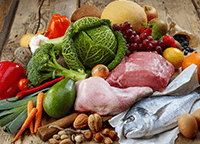Do you ever get overwhelmed by all of the things you want to remember about food?
For many people, knowing which foods are healthiest is a challenge.
It can be hard to keep track of all the different vitamins and minerals, let alone complex information like which have flavanols and which have fiber.
Want an easy-to-remember trick to help you know which foods are doing your body the most good?
The truth is that the more color your fresh produce has, the better it is for you. That’s because of one thing: phytochemicals.
Phytochemicals are only found in plants. They act to protect us from inflammation. They're also a good way to tell that a fruit or vegetable has lots of nutrients.
A Rundown of the Food Rainbow and What It Means
Yellow/Orange
Carrots, cantaloupe, pumpkin and sweet potatoes. These are just a few of the orange foods that are known for their high levels of beta-carotene.
These foods are high in antioxidants and are good for our vision because they contain Vitamin A.
Red
Tomatoes, cranberries, pink grapefruit and watermelon. Most fruits and vegetables that are red contain lycopene.
Lycopene lowers the risk of cancer and improves the health of our tissues. Red foods also contain vitamin C and flavonoids can help reduce inflammation and prevent bacteria from attaching to our cells.
Yellow/Green
Avocado, pistachios, kiwi, leafy greens like spinach, and kale. These foods are high in lutein, which is good for eye health. Kiwi fruit is also high in vitamin C.
Green
Broccoli, Brussels’ sprouts, bok choy and cabbage. Green may be the color we tend to think of most often when it comes to vegetables. There’s good reason for us to think that green is one of the healthiest colors a food can be.
Green vegetables get their color from chlorophyll, and foods that have a lot of chlorophyll are rich in isiothiocyanates. These help the liver move toxins out of our system. They also have vitamin K, folic acid and potassium.
Blue/Purple
Eggplant, blueberries, blackberries, plums and pomegranates. The dark blue and purple colors of these foods comes from anthocyanin. That’s a powerful antioxidant that is heart healthy and lowers high blood pressure. They also fight blood clots.
Black
Black beans, chia seeds, lentils and mushrooms. Black foods are loaded with pigment, and that means that they are high in antioxidants.
There are certainly some healthy foods that are not brightly colored. Adding healthy whole foods like quinoa means that you’re eating a fair amount of beige food, so make sure that they're included on your plate as well!
When you make sure that you’re including all the colors of the rainbow, you’ll be serving up a plate full of good health. Not only that, you will be giving yourself something beautiful to look at while you’re eating.
Yours in health,
Danette
P.S. Please share this and I always love reading your comments below. Do you pay attention to food color?






